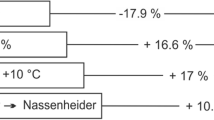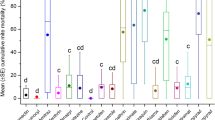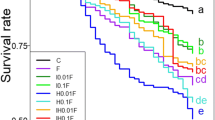Abstract
In order to decrease the variability of formic acid treatments against the honey bee parasite the varroa mite, Varroa destructor, it is necessary to determine the dose-time combination that best controls mites without harming bees. The concentration × time (CT) product is a valuable tool for studying fumigants and how they might perform under various environmental conditions. This laboratory study is an assessment of the efficacy of formic acid against the varroa mite under a range of formic acid concentrations and temperatures. The objectives are 1) to determine the effect of temperature and dose of formic acid on worker honey bee and varroa mite survival, 2) to determine the CT50 products for both honey bees and varroa mites and 3) to determine the best temperature and dose to optimize selectivity of formic acid treatment for control of varroa mites. Worker honey bees and varroa mites were fumigated at 0, 0.01, 0.02, 0.04, 0.08, and 0.16 mg/L at 5, 15, 25, and 35 °C for 12 d. Mite and bee mortality were assessed at regular intervals. Both mite and bee survival were affected by formic acid dose. Doses of 0.08 and 0.16 mg/L were effective at killing mites at all temperatures tested above 5 °C. There was a significant interaction between temperature, dose, and species for the CT50 product. The difference between the CT50 product of bees and mites was significant at only a few temperature-dose combinations. CT product values showed that at most temperatures the greatest fumigation efficiency occurred at lower doses of formic acid. However, the best fumigation efficiency and selectivity combination for treatments occurred at a dose of 0.16 mg/L when the temperature was 35 °C.
Similar content being viewed by others
References
Abbott W.S. 1925. A method of computing the effectiveness of an insecticide. Journal of Economic Entomology 18: 265–267.
Anderson D.L. and Trueman J.W.H. 2000. Varroa jacobsoni (Acari: Varroidae) is more than one species. Experimental and Applied Acarology 24: 165–189.
Batth S.S. 1971. Influence of temperature on the effectiveness of paradichlorobenzene fumigation of webbing clothes moth larvae. Journal of Economic Entomology 64: 989–990.
Baxter J.R., Ellis M.D. and Wilson W.T. 2000. Field evaluation of Apistan® and five candidate compounds for parasitic control in honey bees. American Bee Journal 140: 898–900.
Bogdanov S., Kilchenmann V., Fluri P., Bühler U. and Lavanchy P. 1999. Influence of organic acids and components of essential oils on honey taste. American Bee Journal 139: 61–63.
Bolli H.K., Bogdanov S., Imdorf A. and Fluri P. 1993. DeZur Wirkungsweise von Ameisensäure bei Varroa jacobsoni Oud und der Honigbiene (Apis mellifera L). Apidologie 24: 51–57.
Bond E.J. 1975. Control of insects with fumigants at low temperatures: response to methyl bromide over the range 25° to –6.7 °C. Journal of Economic Entomology 68: 539–542.
Bond E.J. 1984. Manual of Fumigation for Insect Control. Research Centre, Agriculture Canada, London, ON.
Bond E.J., Robinson J.R. and Buckland C.T. 1969. The toxic action of phosphine: absorption and symptoms of poisoning in insects. Journal of Stored Products Research 5: 289–298.
Bracey S. and Fischer F. 1989. Initial results of the field treatment of honey bee colonies infested with Varroa jacobsoni using formic acid in hot climates. American Bee Journal 129: 735–737.
Calderone N.W. 1999. Evaluation of formic acid and a thymol-based blend of natural products for the fall control of Varroa jacobsoni (Acari: Varroidae) in colonies of Apis mellifera (Hymenoptera: Apidae). Journal of Economic Entomology 92: 253–260.
Calderone N.W. and Nasr M.E. 1999. Evaluation of formic acid formulation for the fall control of Varroa jacobsoni (Acari: Varroidae) in colonies of the honey bee Apis mellifera (Hymenoptera: Apidae) in a temperate climate. Journal of Economic Entomology 92: 526–533.
Charriere J.D., Imdorf A. and Kilchenmann V. 1992. Formic acid concentration in the air in a beehive. Schweizerische Bienen-Zeitung 115: 463–469.
Delaplane K.S. and Harbo J.R. 1987. Effect of queenlessness on worker survival, honey gain and defence behaviour in honeybees. Journal of Apicultural Research 26: 37–42.
Eischen F. 1995. Varroa resistance to fluvalinate. American Bee Journal 135: 815–816.
Eischen F.A. 1998. Trials (and tribulations) with formic acid for Varroa control. American Bee Journal 138: 734–735.
Elzen P.J., Eischen F.A., Baxter J.B., Pettis J., Elzen G.W. and Wilson W.T. 1998. Fluvalinate resistance in Varroa jacobsoni from several geographic locations. American Bee Journal 138: 674–676.
Estes P.M. 1965. The effects of time and temperature on methyl bromide fumigation of adults of Sitophilus grenarius and Tribolium confusum. Journal of Economic Entomology 58: 611–614.
Feldlaufer M.F., Pettis J.S., Kochansky J.P. and Shimanuki H. 1997. A gel formulation of formic acid for the control of parasitic mites of honey bees. American Bee Journal 137: 661–663.
Fries I. 1989. Short-interval treatments with formic acid for control of Varroa jacobsoni in honey bee (Apis mellifera) colonies in cold climates. Swedish Journal of Agricultural Research 19: 213–216.
Fries I. 1991. Treatment of sealed honey bee brood with formic acid for control of Varroa jacobsoni. American Bee Journal 131: 313–314.
Garg R., Sharma O.P. and Dogra G.S. 1984. Formic acid: an effective acaricide against Tropilaelaps clareae Delfinado and Baker (Laelaptidae: Acarina) and its effect on the brood and longevity of honey bees. American Bee Journal 124: 736–738.
Harein P.K. and Krause G.F. 1964. Dosage-time relationships between 80: 20 (CCl4:CS2) and adult rice weevils, Sitophilus oryzae. Journal of Economic Entomology 57: 521–522.
Koeniger N. and Rau C. 1980. Field trials in 1979/1980 with formic acid in Hochtaunuskreis. Allgemeine Deutsche Imkerzeitung 14: 157–159.
Lindberg C.M., Melathopoulos A.P. and Winston M.L. 2000. Laboratory evaluation of miticides to control Varroa jacobsoni (Acari: Varroidae), a honey bee (Hymenoptera: Apidae) parasite. Journal of Economic Entomology 93: 189–198.
Liu T.P. 1991. Formic acid and bee mites. American Bee Journal 131: 311–312.
Liu T.P., Chu L.T.Y. and Sporns P. 1993. Formic acid residues in honey in relation to application rate and timing of formic acid for control of tracheal mites, Acarapis woodi (Rennie). American Bee Journal 133: 719–721.
Lodesani M., Colombo M. and Spearfico M. 1995. Ineffectiveness of Apistan® treatment against the mite Varroa jacobsoni Oud. in several districts of Lombardy (Italy). Apidologie 26: 67–72.
Lupo A. and Gerling D. 1990. A comparison between the efficiency of summer treatments using formic acid and Taktic® against Varroa jacobsoni in beehives. Apidologie 21: 261–267.
Maul V., Petersen N. and Wissen W. 1980. Field trials using formic acid as a varroatosis therapy. Allgemeine Deutsche Imkerzeitung 14: 155–157.
Milani N. 1994. Possible presence of fluvalinate-resistant strains of Varroa jacobsoni in northern Italy. In: Matheson A. (ed.), New Perspectives on Varroa. International Bee Research Association, Cardiff, UK, pp. 87.
Milne C.P. Jr. 1982. Early death of newly emerged worker honeybees in laboratory test cages. Journal of Apicultural Research 21: 107–110.
Monro H.A.U. 1969. Manual of Fumigation for Insect Control. Food and Agriculture Organization of the United Nations, Rome, Italy.
SAS Institute 1999. SAS/STAT user's guide. SAS Institute, Cary, NC.
Skinner J.A., Parkman J.P. and Studer M.D. 2001. Evaluation of honey bee miticides, including temporal and thermal effects on formic acid gel vapours, in the central south-eastern USA. Journal of Apicultural Research 40: 81–89.
Simpson J. 1961. Nest climate regulation in honeybee colonies. Science 133: 1327–1333.
Stoya W., Wachendörfer G., Kary I., Siebentritt P. and Kaiser E. 1986. Formic acid as a therapy against Varroatosis and its absorption into honey. Deutsche Lebensmittel-Rundschau 82: 217–221.
Trouiller J. 1998. Monitoring Varroa jacobsoni resistance to pyrethroids in western Europe. Apidologie 29: 537–546.
VonPosern H. 1988. Stopping Varroa's victory march part II. American Bee Journal 128: 425–428.
Westcott L.C. and Winston M.L. 1999. Chemical acaricides in Apis mellifera (Hymenoptera: Apidae) colonies; do they cause nonlethal effects? Canadian Entomologist 131: 363–371.
Author information
Authors and Affiliations
Corresponding author
Rights and permissions
About this article
Cite this article
Underwood, R.M., Currie, R.W. The effects of temperature and dose of formic acid on treatment efficacy against Varroa destructor (Acari: Varroidae), a parasite of Apis mellifera (Hymenoptera: Apidae). Exp Appl Acarol 29, 303–313 (2003). https://doi.org/10.1023/A:1025892906393
Issue Date:
DOI: https://doi.org/10.1023/A:1025892906393




